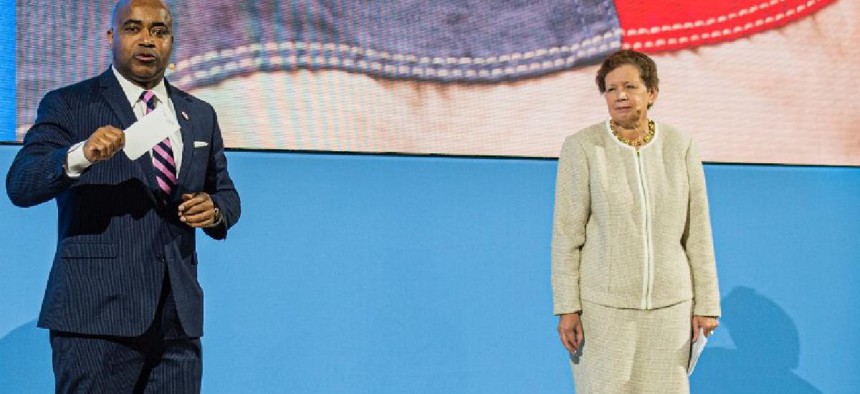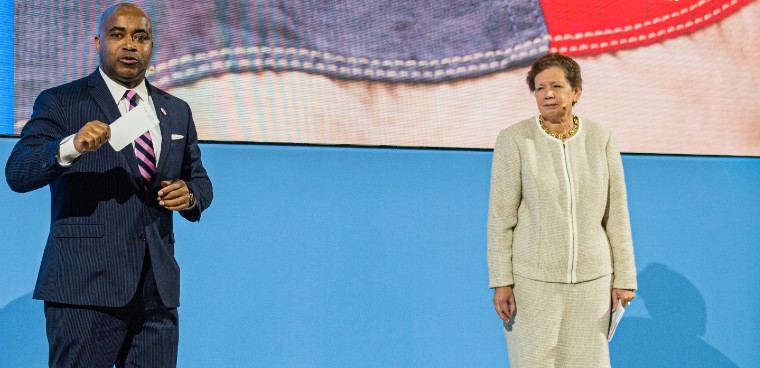VA reboots health record rollout

Leaders of the VA's $16 billion health record modernization plan look to jumpstart their implementation schedule.

Office of Electronic Health Record Modernization Executive Director John H. Windom, left, and Chief Medical Officer Dr. Laura Kroupa speak at the Cerner Health Conference on Oct. 8, 2019. (Photo courtesy: Dept. of Veterans Affairs).
In early August, the Department of Veterans Affairs announced a new schedule for implementing its $16 billion electronic health care reboot, with an initial operating capability set to come online at the Mann-Grandstaff Medical Center in Spokane, Wash.
The work of implementing the new system, based on the Cerner Millennium health record, had been halted because of the COVID-19 pandemic – both because clinicians had to deal with the outbreak and to prevent transmission of the virus among VA workers. But behind the scenes, the effort was kept online.
"We never paused. We never stopped," John Windom, the executive director of VA's Office of Electronic Health Record Modernization, told FCW. "What we did instead was found other avenues to continue to make progress."
This includes developing what VA's is calling the "1.1 capability set" – a version of the Cerner health record with interfaces and coding to support small- and medium-sized hospitals in the VA network.
In mid-February, before it was clear that COVID-19 would bring much of the nation's activity crashing to a halt, VA officials announced that the Mann-Grandstaff rollout would be delayed. That go-live date was tentatively set for July before COVID rewrote much of the federal IT playbook, sending agencies into emergency telework mode.
One aspect of the delay was VA's pledge to go live with expanded functionality – what the agency calls "capability set 1.1" that would support a wider range of clinical activities than was previously envisioned for the launch.
Windom explained that the 1.1 capability set supports small- and medium-sized hospitals, while the 2.0 set will support the functions needed at VA's largest medical centers. Development of the 2.0 capability set "was slowed by the COVID-19 environment because of our access to clinicians who support our workflow development, Windom said. That push is starting up again, but won't be ready until next spring.
"We didn't want to sit on our hands until the spring of 2021," Windom said, so VA looked to other areas where it could maintain and build some momentum.
One opportunity turned out to be in the Midwest. In August, the VA executed on existing plans to implement Cerner scheduling module in Columbus, Ohio.
There is some highly complex history here: VA had previously pursued multiple paths on scheduling technology, in a flurry of contracting and piloting activity that arose from the appointments scandal in Phoenix in 2014. Once VA had settled on Cerner as its health record provider – a decision made to match the Defense Department's selection and guarantee full interoperability between systems – it made sense to go with Cerner's scheduling solution.
The product called the Centralized Scheduling Solution is up and running, and is integrated into VA's existing legacy health record Vista. Among other things, CSS allows patients to schedule medical appointments in primary care and certain specialties via an app, where before they were only allowed to make appointment requests online.
Because of that launch, VA has decided to accelerate the rollout of the entire Cerner system in Veterans Integrated Service Network (VISN) 10 – a regional group of VA facilities in the mid-west that includes Columbus.
Those upgrades will be taking place even as VA builds out VISN 20 – which includes the Pacific Northwest and Alaska. John Short, the chief technology integration officer for EHRM, said that needed infrastructure work was completed for all of VISN 20 during the COVID quarantine period, up to and including facilities in Alaska. That includes the increased bandwidth needed to operate the Cerner product as well as new end-user devices. And as part of the "pivot to VISN 10," Short explained, VA has started installing new equipment in facilities in that region.
The VA is trying to have such infrastructure upgrades completed six months to one year in advance of Cerner go-live dates in order to avoid what have proven to be serious hassles in trying to use the modern software system on slow connections and old equipment.
Contracting for innovation and culture
While the VA is implementing the same underlying system as the Department of Defense, they're going about it in a different way.
DOD cut a deal with Leidos as the prime contractor acting as integrator leading the development and change management efforts to get the Military Health System ready to adopt Cerner. At VA, Cerner is the prime contractor. Windom, who led the DOD acquisition for several years before moving VA explained that culture was the determining factor.
"When I got to the VA, I saw immediately that VA has a different way of doing business," Windom said. "As I reflected on the construct of the DOD contract, where nearly 70% of the care is allocated to the commercial community and in support of DOD, there's a different model here. And so direct access to the…Cerner developers, the people that write the code that people that develop workflows was just far greater with far greater of a need to facilitate user adoption of the Cerner Millennium tool."
Windom added: "It really required a different relationship over here at VA between the prime and the customer than I thought existed with it at DOD."
Dr. Laura Kroupa, chief medical officer for OEHRM, and a practicing physician and medical informatics expert, said that VA's culture and history of being leaders in electronic health record software development and maintenance made it necessary to offer VA practitioners a seat at the table.
"We have a lot of staff across the country who have informatics training and who work in informatics who have a high interest. I mean, we've had to maintain our own EHR all these years," Kroupa said. Additionally, VA offers a wider range of services that need to be taken into account when it comes to designing workflows and interfaces for clinicians.
"So there was never going to be a way for us not to be intimately involved in content development and workflow development, because there's just is too much energy there," Kroupa said.



